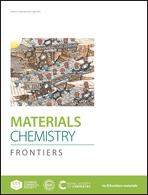Sulfur-modified porous covalent organic polymers as bifunctional materials for efficient fluorescence detection and fast removal of heavy metal ions†
Abstract
As one of the most toxic heavy metals to human beings and the environment, how to simultaneously achieve fluorescence detection and removal of mercury in wastewater is still a challenge and rarely reported. Here, we for the first time synthesize a sulfur-modified covalent organic polymer (COP-108-S) by using facile Ni-catalyzed Yamamoto coupling reactions, and achieve the bifunctional application of COP-108-S for Hg2+ fluorescence detection with a detection limit of 1.44 mM and simultaneous removal with a capacity of 241 mg g−1. On the contrary, the corresponding counterpart (COP-108) without sulfur-modification does not possess the bifunctional property, which means that the sulfur-modification is the key to the bifunctional property of COP-108-S. In addition, COP-108-S also shows good recycle use performance with 99% removal efficiency after five cycles. In short, sulfur-modification may be a useful strategy to develop bifunctional COP materials for simultaneous removal and detection of toxic heavy metal ions.



 Please wait while we load your content...
Please wait while we load your content...